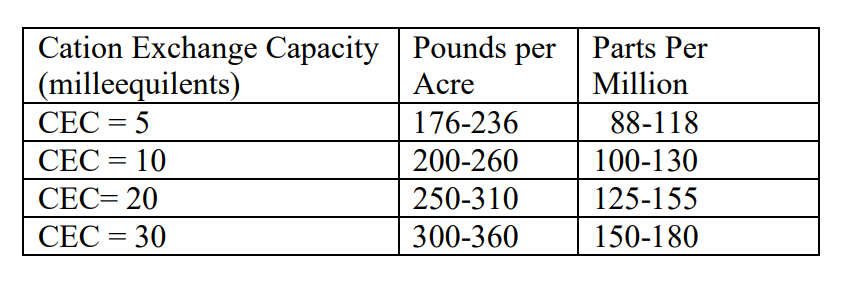Soil Test Interpretation
After harvest, most farmers start planning for next year’s crop. Many farmers start by buying and applying fertilizer before the New Year, for income tax purposes. When deciding how much fertilizer to purchase, start with a good soil test. Greg LaBarge, Agronomy Field Specialist and Laura Lindsey, Assistant Professor, Soybeans and Small Grains Production recently wrote a new fact sheet entitled: Interpreting a Soil Test Report, AGF-514-12 which can be found on Ohioline. This fact sheet is the basis for this article.
Most standardized soil test report values for pH, phosphorus (P), potassium (K), calcium (Ca), and magnesium (Mg). Soil test values are reported in Parts Per Million (PPM) or pounds per acre. The PPM times 2 equal pounds per acre. It is important to note that the soil test values do not actually tell us how many nutrients are in the soil, they indicate the relative nutrient available for crop production. There are generally much higher levels of nutrients in the soil; however, they are simply not available for plant uptake.
The soil pH measures the acidity of a soil. A soil that is neutral has a pH of 7, while an acid soil has lower values and a basic soil has higher values. The pH values can range from 1 (highly acid) to 14 (highly basic), although most soil range from pH 5.0 to 8.0. To improve soil productivity and the release of nutrients, a pH between 6.3 and 7.0 is desirable. Buffer pH (6.8 to 7.0) or Lime Test Index (68 to 70) is the indicator used to determine how much lime is needed to correct soil pH. Most soils in Western Ohio have limestone in the subsoil so they tend to be less acidic than Eastern Ohio with more shale (acidic) soils as the parent material.
Cation Exchange Capacity (CEC) is a measure of how many positive charged nutrients a soil can hold, measured in millequivalents (meq). CEC ranges from 1 to 30+ with sandy coarse textured soils holding less nutrients (CEC=5), medium textured silty soils having a CEC around 10, and fine textured, heavy clay or high organic matter soils having more nutrients (CEC = 20-30+). Soil organic matter (SOM) levels increases the CEC and holds more nutrients. SOM levels range from 1-6% depending upon past management and tillage which decreases SOM levels.
Due to Dissolved Reactive Phosphorus (DRP or soluble P) in Lake Erie causing Harmful Algae Blooms (HAB), farmers are encouraged to closely monitor their soil test values to prevent P leaving the soil. It is estimated, that 90% of the P that runoffs the soil occurs in the 1-2 yearly most extreme runoff events (Sharply, 2012). Dr. Andrew Sharpley, a leading P scientist also says that about 80% of the DRP that is running off the soil is coming from only 20% of the land. Keeping P levels in a reasonable range is critical to controlling the amount of DRP that enters surface water. Unfortunately, the amount needed for good agricultural production is much higher (100 times higher) than what is beneficial in freshwater rivers, streams and lakes. Farmers on average are losing about 2-3 pounds of P per acre but our goal for clean healthy water should be less than 1 pound per acre (Scarpitti, 2012). Acceptable ranges for P are 15 to 30 PPM or 30 to 60 pounds of P/acre.
See table below for acceptable potassium (K) soil test levels which vary by CEC. With K soil test levels, base saturation is useful in determining the amount of exchangeable cations are available. For K, a base saturation of 1-5% is considered desirable.
Table 1: Potassium Soil Test Parameters for Ohio soils
The calcium (Ca) and magnesium (Mg) soil test level varies widely. Ca ranges from 800 to over 16,000 pounds per acre or 400 to 8,000 PPM. The Ca base saturation may range from 40 to 80 percent. For magnesium (Mg), there may be 150 to 2,000 pounds per acre or 75 to 1,000 PPM with a base saturation ranging from 10-40%. Farmers should look at the Ca:Mg ratio of their soils with a good range being 6:1 to 10:1. It is calculated by dividing the base saturation for Ca by the base saturation for Mg. The Mg:K ratio is also helpful and should be greater than 2:1. It is calculated by dividing the base saturation of Mg by the base saturation of K. If the ratio of Mg:K is less than 2:1, the forage consumed by livestock may result in grass tetany, so add magnesium as dolomitic limestone to avoid this problem. For more information on fertilizer guidelines, see the Tristate Fertilizer Recommendations for Corn, Soybeans, Wheat, and Alfalfa, E-2567.
